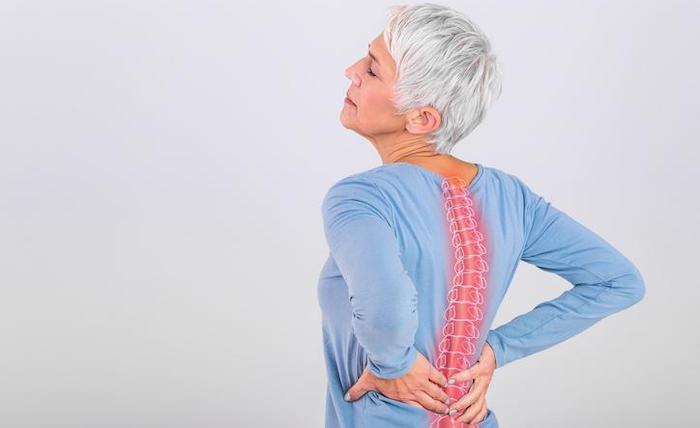
Pain due to arthritis, trauma, or degeneration that affects the spine and surrounding tissues
The spine is a vital structure that supports the body while providing enough flexibility for movement. The spine is divided into the neck (cervical area), middle back (thoracic area), and lower back (lumbar area). Areas that sustain a lot of twisting and bending, such as the lower back, are most likely to get injured. It is estimated that 80% of the population will have lower back pain, or lumbago, in their lifetime.
While some back pain episodes improve with rest, anti-inflammatories, and other conservative treatments, back pain can become severe and chronic. A pain specialist can treat this type of pain with minimally invasive procedures that calm the pain and allow you to strengthen and recondition.
Facts and Information About Back Pain
In most cases back pain can be traced to one of the following issues:
- Muscle or ligament strain. Heavy lifting or sudden awkward movements may tear muscles and ligaments, causing flareups or long-lasting issues like Myofascial Pain Syndrome (MPS).
- Aging of the discs. The discs normally cushion the backbones and absorb shocks during movement. Aged discs can tear, leading to Degenerative Disc Disease (DDD), a painful neck and back condition.
- Bulging or ruptured disks. Due to aging or trauma, the soft gel material inside a disk can bulge or rupture and start to irritate or press on a spinal nerve.
- Worn joints. The small facet joints of the spine tend to wear down with age, trauma, or arthritis. This leads to Facet Joint Syndrome, a condition that causes back pain, stiffness, and muscle spasms.
- Pinched nerves. Herniated disks or bone spurs can press on a spinal nerve and disrupt its function (Radiculopathy), causing back pain and leg tingling, numbness, or weakness.
- Narrowing of the spinal canal. Degenerated (aged) spinal discs and bone spurs lead to a painful narrowing of the spinal canal or Spinal Stenosis.
- Spinal fracture. A Spinal Compression Fracture is a break in one of the backbones. Commonly linked to osteoporosis, these fractures are a common cause of lower back pain in females.
- Slippage and misalignment of the vertebrae. Degenerated discs and bone spurs cause the backbones to slip forward, triggering lower back pain and Sciatica.
- Sacroiliac (SI) Joint Dysfunction. Wear-and tear or arthritis of the large SI joint that links the upper body to the pelvis causes back pain and inflammation in the buttocks and thigh.
- Deformity of the spine. A person may be born with an exaggerated curve of the spine that presses on the discs and joints.
- Infection or tumor. Certain infections and tumors can affect the backbones or enter the spinal canal.
- Trauma. Sudden fractures or spinal dislocations may cause back pain.
Symptoms Linked To Back Problems
Back pain may be episodic, where a person flares up and recovers, or it may become chronic and last several weeks or months. It usually worsens with bending, twisting, lifting, standing, or walking. Sometimes, as with rheumatoid arthritis, movement improves the stiffness while excessive rest worsens the pain.
Common findings in people with back problems:
- Muscle spasms and weakness
- Decreased ability to twist or bend
- Numbness, tingling in the upper body
- Numbness or tingling in legs/feet
- Pain in the buttocks, hips, legs
- A visible curve in the spine
- Hunched appearance
Situations, where there is pressure on the spinal cord, are considered emergencies. You should see a doctor immediately if you have:
- Loss of bowel or bladder control
- Loss of balance or coordination
How Back Pain Starts
Back pain is often linked to an injury or to spinal degeneration, a process of wear-and-tear of the joints, discs, ligaments, and bones in the spine. Over time, one back problem can lead to other problems, creating a domino effect of cumulative issues.
Issues that increase the risk for back pain:
- Poor posture
- Weakened core and back muscles
- Improper lifting technique
- Overuse (high impact sports like running, basketball)
- Accidents or collisions
- Advanced age
- Female gender
- Other musculoskeletal pain
Diagnosis
A diagnosis for back pain requires an evaluation from a pain specialist and a complete neurologic examination. The presence of joint or disc problems on X-rays, MRI’s and other imaging studies, does not guarantee that the back pain necessarily stems from these issues. Some people may show problems on the imaging studies without having any pain symptoms. Other people have considerable back pain and normal imaging studies.
For an accurate diagnosis you may need:
- Labs
- X-rays, MRIs, and CT scans
- Discography
- Electrodiagnostic tests
Treating Back Pain
Most episodes of back pain will improve with conservative treatments like rest, ice/heat, massage, and physical therapy. Lower back exercises and stretches can help, while excessive bed rest can prolong the pain.
Consider seeing a pain specialist if the pain:
- Does not respond to over-the-counter medications
- Gets worse
- Accompanies a loss of bowel/bladder control
- Includes leg weakness
Precision Pain Care and Rehabilitation has two convenient locations in Richmond Hill – Queens and New Hyde Park – Long Island. Call the Richmond Hill office at (718) 215-1888, or (516) 419-4480 for the Long Island office, to arrange an appointment with our Interventional Pain Management Specialist, Dr. Jeffrey Chacko.













